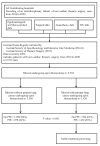Risk Factors for Postoperative Pulmonary Complications Leading to Increased In-Hospital Mortality in Patients Undergoing Thoracotomy for Primary Lung Cancer Resection: A Multicentre Retrospective Cohort Study of the German Thorax Registry
- PMID: 36233649
- PMCID: PMC9572507
- DOI: 10.3390/jcm11195774
Risk Factors for Postoperative Pulmonary Complications Leading to Increased In-Hospital Mortality in Patients Undergoing Thoracotomy for Primary Lung Cancer Resection: A Multicentre Retrospective Cohort Study of the German Thorax Registry
Abstract
Postoperative pulmonary complications (PPCs) represent the most frequent complications after lung surgery, and they increase postoperative mortality. This study investigated the incidence of PPCs, in-hospital mortality rate, and risk factors leading to PPCs in patients undergoing open thoracotomy lung resections (OTLRs) for primary lung cancer. The data from 1426 patients in this multicentre retrospective study were extracted from the German Thorax Registry and presented after univariate and multivariate statistical processing. A total of 472 patients showed at least one PPC. The presence of two PPCs was associated with a significantly increased mortality rate of 7% (p < 0.001) compared to that of patients without or with a single PPC. Three or more PPCs increased the mortality rate to 33% (p < 0.001). Multivariate stepwise logistic regression analysis revealed male gender (OR 1.4), age > 60 years (OR 1.8), and current or previous smoking (OR 1.6), while the pre-operative risk factors were still CRP levels > 3 mg/dl (OR 1.7) and FEV1 < 60% (OR 1.4). Procedural independent risk factors for PPCs were: duration of surgery exceeding 195 min (OR 1.6), the amount of intraoperative blood loss (OR 1.6), partial ligation of the pulmonary artery (OR 1.5), continuing invasive ventilation after surgery (OR 2.9), and infusion of intraoperative crystalloids exceeding 6 mL/kg/h (OR 1.9). The incidence of PPCs was significantly lower in patients with continuous epidural or paravertebral analgesia (OR 0.7). Optimising perioperative management by implementing continuous neuroaxial techniques and optimised fluid therapy may reduce the incidence of PPCs and associated mortality.
Keywords: in-hospital mortality of thoracotomy; lung cancer resection; post-operative pulmonary complications; thoracotomy.
Conflict of interest statement
The authors declare no conflict of interest.
Figures




References
-
- Shelley B.G., McCall P.J., Glass A., Orzechowska I., Klein A.A., Association of Cardiothoracic Anaesthesia and collaborators Association between Anaesthetic Technique and Unplanned Admission to Intensive Care after Thoracic Lung Resection Surgery: The Second Association of Cardiothoracic Anaesthesia and Critical Care (ACTACC) National Audit. Anaesthesia. 2019;74:1121–1129. doi: 10.1111/anae.14649. - DOI - PubMed
LinkOut - more resources
Full Text Sources
Research Materials
Miscellaneous

